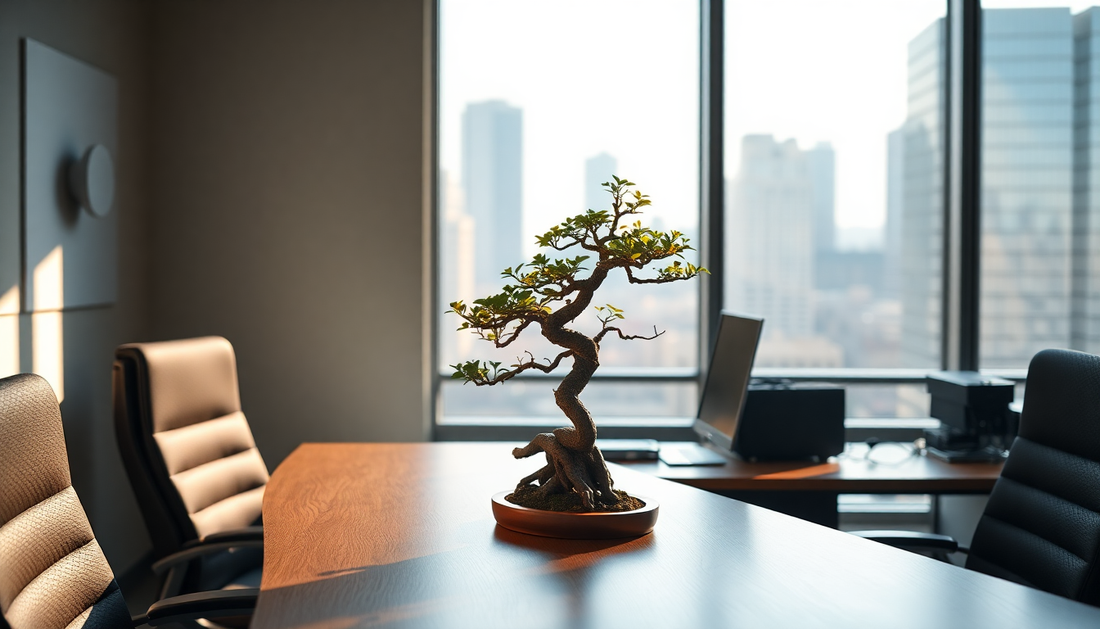
Bring the Serenity of Nature to Your Workspace: A Guide to Caring for Bonsai Trees in Office Environments
Share
In the bustling world of modern offices, where the lines between work and life often blur, finding moments of tranquility can be a true oasis. One way to bring a touch of nature's calming influence into your workspace is by cultivating the art of bonsai tree care. These miniature marvels not only add a touch of elegance to any office setting but also offer a soothing respite from the daily grind.
The Allure of Bonsai in the Office
Bonsai trees have long been revered for their ability to transport the viewer to a serene, natural world, even in the most urban of environments. Their delicate branches, intricate root structures, and carefully sculpted forms captivate the senses, inviting a moment of mindfulness and reflection. In the context of an office, these living works of art can have a profound impact on both productivity and well-being.
The Calming Influence of Bonsai
Numerous studies have shown that the presence of plants in the workplace can have a positive effect on employee stress levels, mood, and overall job satisfaction. Bonsai trees, with their meditative qualities, take this a step further. The act of caring for these miniature masterpieces can be a form of active meditation, allowing individuals to focus their attention and find a sense of calm amidst the chaos of the workday.
Boosting Creativity and Focus
In addition to their soothing effects, bonsai trees can also stimulate the creative mind. The intricate details and delicate balance of these living sculptures can inspire new perspectives and encourage innovative thinking. By incorporating bonsai into the office environment, employers can foster a culture of mindfulness and creativity, ultimately leading to enhanced productivity and problem-solving abilities.
Selecting the Right Bonsai for Your Office
When choosing a bonsai tree for your office, it's important to consider factors such as light exposure, temperature, and maintenance requirements. Some of the most popular and well-suited bonsai species for indoor environments include:
Ficus (Ficus Retusa)
The Ficus, or Ficus Retusa, is a hardy and adaptable bonsai that thrives in a wide range of lighting conditions, making it an excellent choice for office spaces. Its lush, glossy leaves and intricate trunk structures add a touch of elegance to any desk or shelf.
Chinese Elm (Ulmus Parvifolia)
The Chinese Elm is a resilient bonsai that can tolerate fluctuations in temperature and humidity, making it well-suited for the often-unpredictable climate of an office. Its delicate, serrated leaves and graceful branching patterns create a visually stunning display.
Japanese Juniper (Juniperus Procumbens)
The Japanese Juniper is a low-maintenance bonsai that can adapt to a variety of lighting conditions. Its distinctive, needle-like foliage and compact growth habit make it an ideal choice for smaller office spaces.
When selecting your bonsai, be sure to consider the size of your office and the available space for the tree to thrive. Smaller bonsai varieties may be better suited for cramped desks, while larger specimens can make a bold statement in more spacious areas.
Mastering the Art of Bonsai Care
Caring for a bonsai tree in an office environment requires a delicate balance of attention and patience. Here are some key tips to ensure the long-term health and vitality of your miniature masterpiece:
Lighting and Placement
Bonsai trees require a specific amount of sunlight to thrive. Positioning your bonsai near a sunny window or under a grow light can ensure it receives the necessary illumination. Avoid placing the tree in direct sunlight, as this can scorch the delicate leaves.
Watering and Humidity
Maintaining the right moisture level is crucial for bonsai health. Check the soil regularly and water when the top inch or two becomes dry. Avoid letting the soil become completely saturated, as this can lead to root rot. Additionally, consider using a pebble tray or small humidifier to increase the ambient humidity around your bonsai.
Fertilizing and Pruning
Bonsai trees require regular fertilization to support their growth and development. Use a balanced, water-soluble fertilizer and follow the manufacturer's instructions. Pruning is also essential to maintain the tree's shape and encourage new growth. Consult a bonsai expert or refer to detailed guides to learn the proper techniques for your specific species.
Seasonal Adjustments
Bonsai trees have specific needs that vary with the changing seasons. In the spring and summer, they may require more frequent watering and fertilization to support new growth. During the fall and winter, reduce watering and fertilization to allow the tree to enter a dormant phase.
Monitoring and Troubleshooting
Regularly inspect your bonsai for signs of stress or pests. Discolored leaves, wilting, or insect infestations may indicate a problem that requires immediate attention. Consult with a bonsai specialist or refer to online resources to diagnose and address any issues that arise.
Embracing the Bonsai Lifestyle in the Office
Caring for a bonsai tree in the office can be a rewarding and enriching experience. By incorporating these living works of art into your workspace, you can not only enjoy their aesthetic beauty but also reap the benefits of their calming influence and creative inspiration.
Remember, the journey of bonsai care is one of patience, mindfulness, and a deep appreciation for the natural world. Embrace the challenges and the triumphs, and let your bonsai tree become a source of tranquility and inspiration in your daily work life.
So, why not take the first step and bring the serenity of nature into your office today? Discover the transformative power of bonsai and unlock a new level of focus, creativity, and well-being in your workspace.
